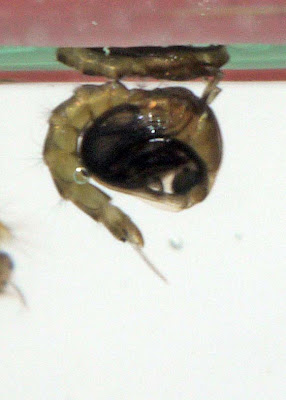Thursday's Guardian Country Diary describes the mosquitoes that breed in almost every small accumulation of rain water in our garden. The sultry wet weather that we've experienced lately has provided perfect breeding conditions for the larval stages and I've been watching their development.
These are the larvae, hanging from the water surface by their tail breathing siphons. Those jaws are less menacing than they look - the mouth is fringed with small whiskers that constantly move, creating a water current and filtering out food particles. The larvae of this species, Culex pipiens, moult four times as they grow and you can see two developmental stages in the photo above - the larger larvae are at their final stage of development and are ready to become .....
....... pupae. You can see a comma-shaped pupa floating amongst this gang of larvae.
The pupae hang from the surface with two breathing tubes on the head that resemble devilish little horns.
The pupal stage is relatively brief and as the mosquito develops inside and they move closer to hatching they become darker, like the one on the right. The larvae are very active, wriggling down to the bottom of the water at the slightest disturbance, but the pupae are positively hyperactive if you disturb them, tumbling as they dive.
When they are ready to hatch the pupae float passively on the surface and their tails straighten, like the one at back that you can see here. Then ....................
Their exoskeleton splits along the back and a mosquito's head and antennae appear above the surface.
Some don't make the successful transition from water to air if they are disturbed during this critical step - the one on the left has become trapped in the surface tension and has drowned; you can see the empty pupal skin floating below it.
The photographs below show several more stages in a successful emergence. Adult mosquitoes look menacing from the moment they appear above the surface, don't they, with those intricate, ultra-sensitive feathery antennae and suctorial mouthparts? They have their own brand of sinister beauty - you can see view some images of their rather beautiful eyes by clicking here.
The sequence of six photographs below show another successful emergence.
It's only in the third photograph that the legs begin to play a part; before that the insect just wriggles out of the pupal skin, perhaps aided by those backwards-curved hairs. The strange discontinuity that you can see bisecting the mosquito here is an optical artefact, caused by the water meniscus on the side of the glass container.
Once the insect's legs are free it can rest them on the surface film and finally lever its abdomen out of the pupal skin, until ...........
..........finally it's free.
The species in these photographs is Culex pipiens. It spends autumn feeding of plant juices and the mated females that survive the winter will need a blood meal before they can lay eggs and produce the next generation in summer 2014. Fortunately this species feeds on the blood of birds rather than humans.
Many will not survive the autumn; thousands become trapped in spiders' webs. They are also important food items for birds like swallows and house martins and the pipistrelle bats that hunt over our garden will probably catch them in large numbers too.









































And exactly how long does this fascinating transformation take place, just so we know how often to refresh standing water in the garden?
ReplyDeleteCa't really be exact because it depends of the species of mosquito, but some can get through their whole life cycle, from egg to adult, in under two weeks
DeleteThey might feed on blood other than human but they still make my flesh crawl!
ReplyDeleteNot my favourite insect either, toffeeapple...
Delete